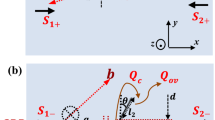Abstract
Zigzag-edged graphene nanoribbon (ZGNR) has great potential in designing quantum waveguide devices to conduct electric currents metallically. Using non-equilibrium Green’s function (NEGF) method, we theoretically study geometry dependent transport properties and current–voltage (I–V) characteristics of T-stub ZGNR quantum waveguides sized in tens of nanometers. Instead of the perfect transmission in straight ZGNR, anti-resonance effects appear in transmission spectrum due to strong electronic reflection depending on the size of central region in T-stub ZGNR. In addition, the I–V characteristics of T-stub ZGNR quantum waveguides are mainly influenced by the transverse width of the central region. Meanwhile, the current flowing over the T-stub ZGNR quantum waveguides gradually converges as the longitudinal length of the central region increases. We also find that a single edge-defect at certain positions of the central region may slightly suppress the transmission and reduce the current. Our findings provide a viable design option for adjusting current response in graphene-based quantum devices.
Graphic Abstract








Similar content being viewed by others
Data Availability Statement
This manuscript has no associated data or the data will not be deposited. [Authors’ comment: All the results presented in the paper can be reproduced with the information provided in the manuscript.]
References
M. Sledzinska, B. Graczykowski, J. Maire et al., Adv. Func. Mater. 30, 1904434 (2020)
W. Li, F. Meng, Y. Chen et al., Adv. Theory Simul. 2, 1900017 (2019)
C. Muhammad, Lim, J.Reddy, et al., Mech. Adv. Mater. Struct. 27, 1053–1064 (2020)
A. Weisshaar, J. Lary, S.M. Goodnick et al., J. Appl. Phys. 70, 355–366 (1991)
H. Shin, W. Qiu, R. Jarecki et al., Nat. Commun. 4, 1–10 (2013)
Ü. Keleş, A. Çakan, C. Bulutay, J. Appl. Phys. 117, 064308 (2015)
E. Kim, X. Zhang, V.S. Ferreira et al., Phys. Rev. X 11, 011015 (2021)
P. Debray, O. Raichev, P. Vasilopoulos et al., Phys. Rev. B 61, 10950–10958 (2000)
K.M. Li, Z.X. Xie, K.L. Su et al., Phys. Lett. A 378, 1383–1387 (2014)
C. Liu, J. Zhang, M. Muruganathan et al., Carbon 165, 476–483 (2020)
C.H. Chen, W.W. Li, Y.M. Chang et al., Phys. Rev. Appl. 10, 044047 (2018)
Y. Betancur-Ocampo, E. Paredes-Rocha, T. Stegmann, J. Appl. Phys. 128, 114303 (2020)
M. Kim, J.H. Choi, S.H. Lee et al., Nat. Phys. 12, 1022–1026 (2016)
N.A. Shah, V. Mosallanejad, K.L. Chiu et al., Phys. Rev. B 100, 125412 (2019)
A. Cheng, T. Taniguchi, K. Watanabe et al., Phys. Rev. Lett. 123, 216804 (2019)
Y. Ren, P. Wan, L. Zhou et al., Phys. Rev. B 103, 085431 (2021)
Z. Zhang, Z. Wu, K. Chang et al., Nanotechnology 20, 415203 (2009)
Z. Wu, Z. Zhang, K. Chang et al., Nanotechnology 21, 185201 (2010)
E.J. Ye, Y. Nie, H. Shi et al., J. Appl. Phys. 117, 014303 (2015)
L. Zhang, J. Phys.: Condens. Matter 29, 055304 (2016)
J. Xu, L. Wang, M. Weng, J. Appl. Phys. 114, 153701 (2013)
Y.J. Shi, J. Lan, E.J. Ye et al., Eur. Phys. J. B 87, 1–5 (2014)
M. Kruskopf, A.F. Rigosi, A.R. Panna et al., IEEE Trans. Electron Dev. 66, 3973–3977 (2019)
A. Badmaev, Y. Che, Z. Li et al., ACS Nano 6, 3371–3376 (2012)
J. Sui, K.L. Wu, IEEE Trans. Microw. Theory Tech. 65, 2111–2121 (2017)
H. Yin, Mod. Phys. Lett. B 24, 1173–1184 (2010)
J. Lan, E.J. Ye, W.Q. Sui et al., Phys. Chem. Chem. Phys. 15, 671–679 (2013)
V.H. Nguyen, J. Saint-Martin, D. Querlioz et al., J. Comput. Electron. 12, 85–93 (2013)
S. Moysidis, I.G. Karafyllidis, Microelectron. J. 72, 11–13 (2018)
Q. Zhang, K. Chan, Phys. Lett. A 383, 1967–1971 (2019)
D.L. Tiwari, K. Sivasankaran, Superlattices Microstruct. 136, 106308 (2019)
S.Z. Ye, H. Wang et al., Phys. Chem. Chem. Phys. 22, 18265–18271 (2020)
C. Liu, J. Zhang et al., Carbon 165, 476–483 (2020)
W.S. Hwang, P. Zhao et al., 2D Mater. Appl. 3, 1–7 (2019)
X. Zhang, Y. Liu, AIP Adv. 9, 115209 (2019)
K. Wakabayashi, K.I. Sasaki, T. Nakanishi et al., Sci. Technol. Adv. Mater. 11, 054504 (2010)
K. Nakada, M. Fujita et al., Phys. Rev. B 54, 17954 (1996)
L. Brey, H.A. Fertig, Phys. Rev. B 73, 235411 (2006)
Acknowledgements
The work in this study is supported by the National Natural Science Foundation of China (Grant Nos. 61874078, 61904125), the National KeyResearch and Development Program of China (Grant No. 2018YFB2202100) and the Natural Science Foundation of Zhejiang Province, China (Grant No. LY20F040007).
Author information
Authors and Affiliations
Contributions
Peng-Jun Wang, Yi-Jian Shi and Yuan-Chun Wang all participated in the design of this study. Yi-Jian Shi and Yuan-Chun Wang established the theoretical model and carried out the numerical simulations. Yi-Jian Shi and Yuan-Chun Wang interpreted and concluded the results. Yuan-Chun Wang wrote the first draft of the manuscript. Peng-Jun Wang and Yi-Jian Shi supervised the project and revised the final manuscript.
Corresponding author
Supplementary Information
Below is the link to the electronic supplementary material.
Rights and permissions
About this article
Cite this article
Wang, YC., Shi, YJ. & Wang, PJ. Geometry dependent current–voltage characteristics of T-stub zigzag-edged graphene nanoribbon quantum waveguides. Eur. Phys. J. B 95, 35 (2022). https://doi.org/10.1140/epjb/s10051-022-00297-x
Received:
Accepted:
Published:
DOI: https://doi.org/10.1140/epjb/s10051-022-00297-x




